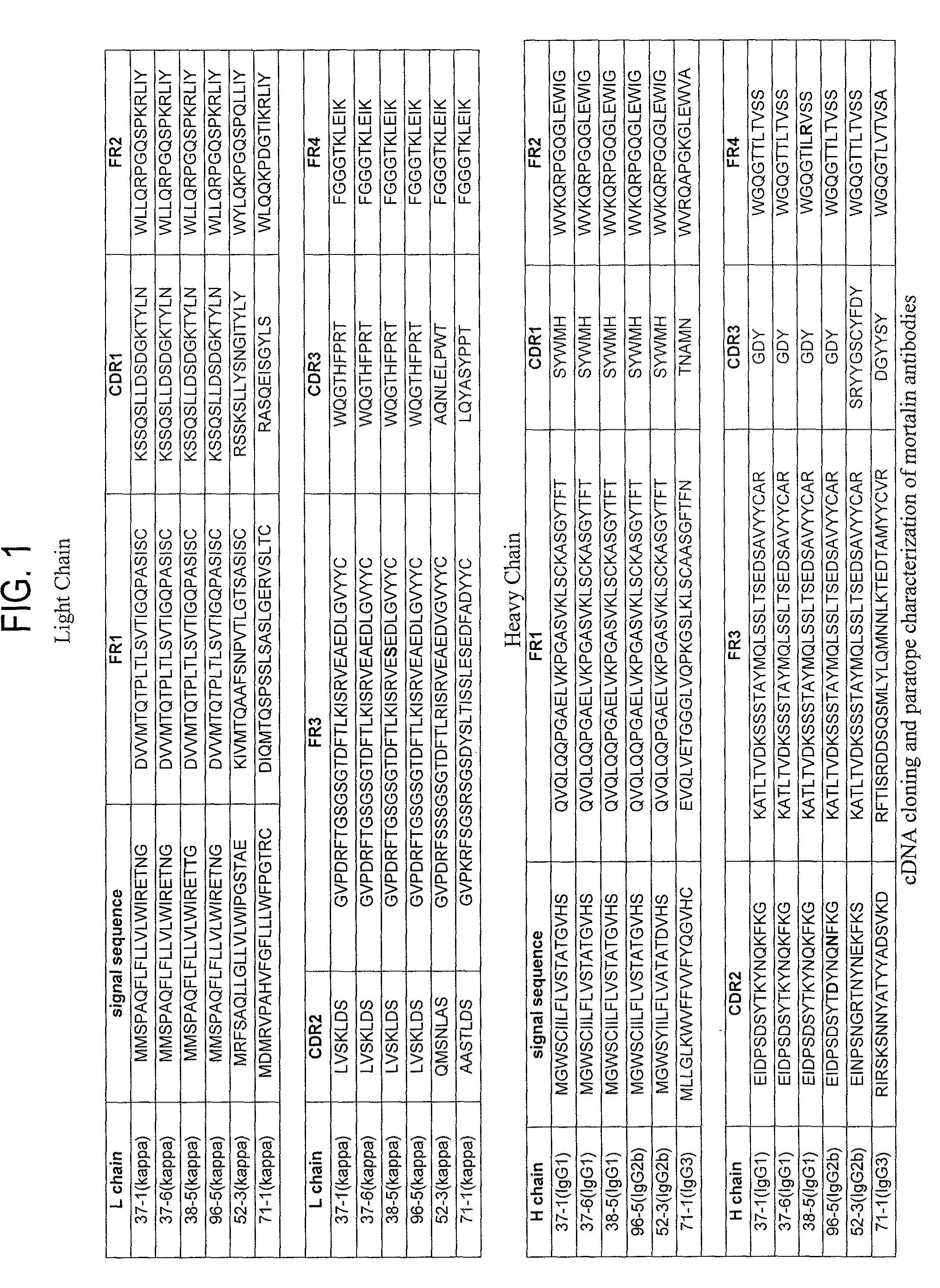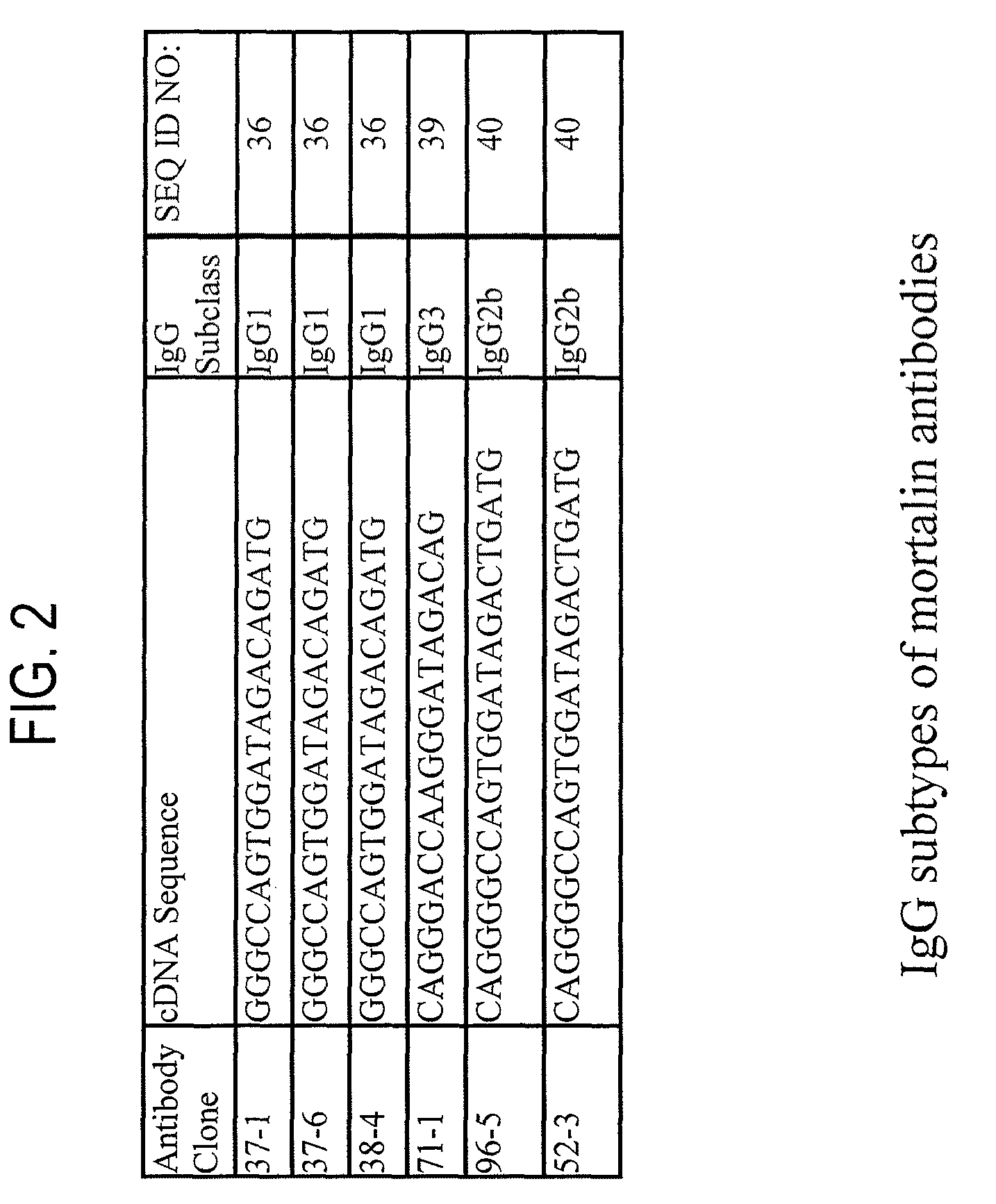Paratope and epitope of anti-mortalin antibody
an anti-mortalin antibody and paratope technology, applied in the field of paratope and epitope of anti-mortalin antibody, can solve the problems of essential differences in amino acid sequences or structures between antibodies having internalizing functions and cells without such functions, and achieve the effect of suppressing mortalin activity and better internalizing function
- Summary
- Abstract
- Description
- Claims
- Application Information
AI Technical Summary
Benefits of technology
Problems solved by technology
Method used
Image
Examples
example 1
Sequencing of Variable Regions
1.1. Isolation of Total RNA
[0197]Among anti-mortalin antibodies, hybridomas producing monoclonal antibodies (37-1, 37-6, 38-5, 96-5, and 71-1) having a internalizing function into cancer cells and hybridomas producing monoclonal antibodies not having such internalizing function were separately cultured at a cell concentration of 1×106 cells / mL or less (approximately 10 mL). Cells were recovered and then stored at −20° C. until RNA extraction. Cells were thawed on ice, RNA extraction was carried out using an RNeasy Mini kit (QIAGEN, cat.No. 74104), and then each total RNA was prepared.
1.2. 1st strand cDNA Synthesis
[0198]1st strand cDNA synthesis was carried out using SMART RACE cDNA Amplification (Clontech, cat.No. 634914), RNA (1 μg) obtained in the above section 1. as a template, and 5′CDS primers.
1.3. 5′-RACE
[0199]Touch-down PCR was carried out using an Advantage 2 PCR Kit (Clontech, cat. No. K1910-y) included in SMART RACE cDNA Amplification and 2.5 ...
example 2
Construction of scFv Against Mortalin and Expression Plasmid Vector therefor
2.1. Vector Design
[0205]The gene of a single-chain antibody (single chain Fv, scFv) was constructed using cDNA of the antibody obtained from the hybridoma producing the monoclonal antibody 37-1 against mortalin. The scFv was prepared by linking antibody heavy-chain and light-chain variable regions (VH and VL) using an appropriate peptide linker, which could be expressed by Escherichia coli and purified. The scFv gene was cloned into the recombinant protein expression plasmid vector pET-27b(+) having a PelB sequence that is a signal sequence for transport of the translated protein to the Escherichia coli periplasmic region. First, the VL gene was amplified using a primer set of Primer 1 and Primer 2 and the VH gene was amplified using a primer set of Primer 3 and Primer 4. Primer 2 contained a polypeptide sequence for linking VL and VH, and each amplification product was designed so that the C-terminal-side p...
example 3
Epitope Mapping
3.1. Expression and Purification of Full-Length Mortalin and Deletion Mutant Protein of Mortalin
[0210]The full-length sequence of mortalin with an His tag added thereto was cloned into BamH I and Sal I multicloning sites of a pQE30 plasmid vector (QIAGEN) and then expressed by Escherichia coli. The pQE30 plasmid vector causes the expression of the protein in which a His tag has been added to the N-terminus of the cloned protein, and the protein can be conveniently purified with Ni-NTA agarose gel. pQE30 / full-length mortalin and pQE3Odel-mot plasmid vectors of various types of deletion mutant mortalin shown in FIGS. 8-10 were transformed into Escherichia coli M15. Single colonies were cultured using LB medium at 37° C. IPTG (isopropyl-1-thio-β-D-galactopyranoside) was added to 1 mM when the absorbance at 600 nm was approximately 0.4. After 5 hours of further culturing at 37° C., cells were recovered. A pellet was suspended in buffer A (100 mM NaH2PO4, 10 mM Tris-Hcl (p...
PUM
| Property | Measurement | Unit |
|---|---|---|
| dissociation constant | aaaaa | aaaaa |
| pH | aaaaa | aaaaa |
| pH | aaaaa | aaaaa |
Abstract
Description
Claims
Application Information
 Login to View More
Login to View More - R&D Engineer
- R&D Manager
- IP Professional
- Industry Leading Data Capabilities
- Powerful AI technology
- Patent DNA Extraction
Browse by: Latest US Patents, China's latest patents, Technical Efficacy Thesaurus, Application Domain, Technology Topic, Popular Technical Reports.
© 2024 PatSnap. All rights reserved.Legal|Privacy policy|Modern Slavery Act Transparency Statement|Sitemap|About US| Contact US: help@patsnap.com










